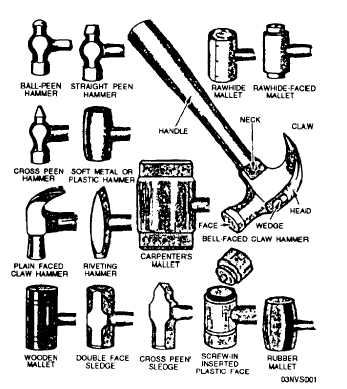tools results in improper maintenance. Improper maint
enance results in damage to equipment and possible
injury or death to you or others.
SAFE MAINTENANCE PRACTICES–Always
avoid placing tools on or above machinery or an
electrical apparatus.
Never leave tools unattended
where machinery or aircraft engines are running.
NEVER USE DAMAGED TOOLS – A battered
screwdriver may slip and spoil the screw slot, damage
other parts, or cause painful injury. A gauge strained
out of shape will result in inaccurate measurements.
Remember, the efficiency of craftsmen and the
tools they use are determined to a great extent by the
way they keep their tools.
Likewise, they are
frequently judged by the manner in which they handle
and care for them.
Anyone watching skilled
craftsmen at work notices the care and precision with
which they use the tools of their trade.
The care of hand tools should follow the same
pattern as for personal articles; that is, always keep
hand tools clean and free from dirt, grease, and
foreign matter. After use, return tools promptly to
their proper place in the toolbox. Improve your own
efficiency by organizing your tools so that those used
most frequently can be reached easily without digging
through the entire contents of the box.
Avoid
accumulating unnecessary junk.
STRIKING TOOLS
Hammers, mallets, and sledges are used to apply
a striking force. The tool you select (fig. 1-1) will
depend upon the intended application.
HAMMERS
A toolkit for nearly every rating in the Navy
would not be complete without at least one hammer.
In most cases, two or three are included, since they
are designated according to weight (without the
handle) and style or shape. The shape will vary
according to the intended work.
Machinists’ Hammers
Machinists’ hammers are mostly used by
who work with metal or around machinery.
people
These
hammers are distinguished from carpenter hammers by
a variable-shaped peen, rather than a claw, at the
Figure 1-1.-Hammers mallets, and sledges.
opposite end of the face (fig. 1-1). The ball-peen
hammer is probably most familiar to you.
The ball-peen hammer, as its name implies, has a
ball that is smaller in diameter than the face. It is
therefore useful for striking areas that are too small
for the face to enter.
Ball-peen hammers are made in different weights,
usually 4, 6, 8, and 12 ounces and 1, 1 1/2, and 2
pounds. For most work a 1 1/2 pound and a 12-ounce
hammer will suffice.
However, a 4- or 6-inch
hammer will often be used for light work such as
tapping a punch to cut gaskets out of sheet gasket
material.
Machinists’ hammers may be further divided into
hard-face and soft-face classifications. The hard-faced
hammer is made of forged tool steel, while the
soft-faced hammers have a head made of brass, lead,
or a tightly rolled strip of rawhide. Plastic-faced
hammers or solid plastic hammers with a lead core for
added weight are becoming increasingly popular.
Soft-faced hammers (fig. 1-1) should be used
when there is danger of damaging the surface of the
work, as when poundind on a machined surface.
1-2

